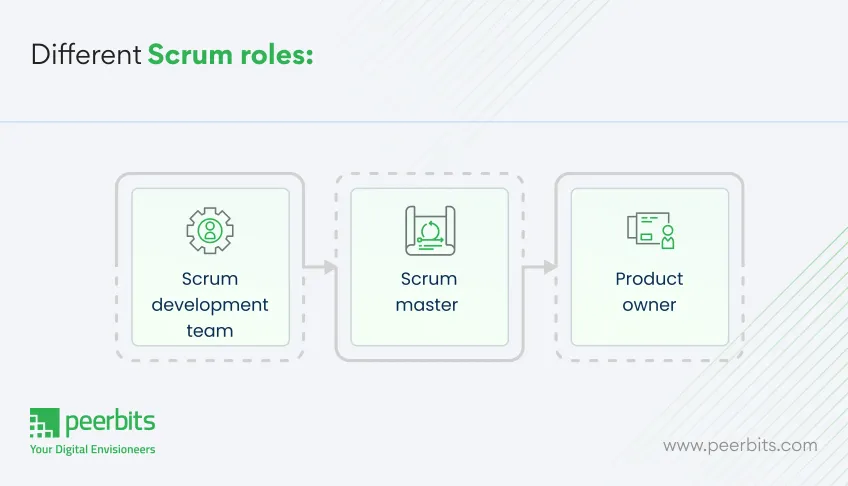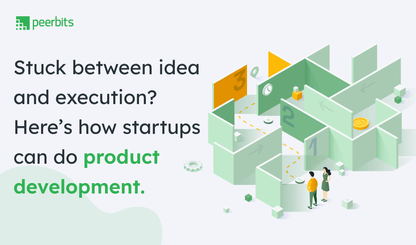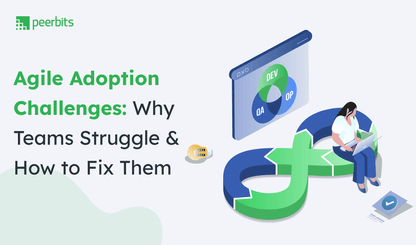Many organizations struggle with unclear task prioritization, missed deadlines, and team misalignment. To solve such day-to-day challenges with better predictability, various project management frameworks have emerged in recent years.
Initially designed for software development teams, Scrum has been widely adopted across various industries due to its flexibility, iterative approach, and focus on collaboration and efficiency.
A Project Management Institute (PMI) report shows that over half of project managers using Agile frameworks prefer Scrum for handling project complexities. Approximately 55% of organizations report some level of reliance on Scrum in their operations.
Well if it’s such a hype, then what makes it so approachable? And how it can be helpful for your business? Or how you can get started with Scrum? Let’s find out.
Here’s a complete guide to the Scrum methodology, highlighting essentials of Scrum project management, including its principles, roles, tools, and how it compares to other methodologies. We’ll also explore implementation strategies and real-world examples to help you determine if Scrum suits your business needs.
Overview of Scrum
Scrum is an agile project management method that helps teams work together effectively to solve problems and deliver high-quality results. It focuses on being flexible, open, and making steady progress by gathering feedback and improving step by step.
While Scrum started in custom software development, it has grown to be a popular choice in many industries such as healthcare, IT, retail, e-commerce, Finance & bankig etc. for tackling challenges and achieving goals.
Key features in Scrum that benefit businesses
With Scrum, businesses can cut costs, improve productivity, and stay ahead of challenges. Let’s explore the core features of scrum that makes it beneficial for variety of businesses:
1. Flexible structure: Scrum uses incremental processes within a flexible framework, allowing teams to adapt and meet changing requirements.
2. Quick, functional releases: Rather than following rigid steps, Scrum focuses on delivering small, functional updates during each sprint (iteration).
3. Cost and time efficiency: Adopting Scrum helps businesses cut development costs, speed up returns, improve customer response, and boost team satisfaction.
4. Collaborative approach: Unlike traditional methods, Scrum fosters teamwork by aligning multiple teams and goals, allowing the project to evolve together.
5. Clear framework: Scrum follows a well-defined structure with four key ceremonies to guide the process:
- Sprint planning: The team sets goals and plans tasks for the upcoming sprint, ensuring alignment on priorities.
- Sprint demo: Completed work is presented to stakeholders for feedback, ensuring it meets customer needs.
- Daily standup: A brief daily meeting to discuss progress, challenges, and plans, keeping the team on track.
- Sprint retrospective: The team reviews the sprint to identify successes and areas for improvement, driving continuous growth.
Note: A sprint is a set period (1-4 weeks) where a team works on specific tasks to complete a functional product increment. It enables continuous progress and regular feedback.

Agile vs Scrum vs Kanban: What’s the difference?
When comparing Agile, Scrum, and Kanban, it’s important to know how each methodology suits different types of projects. Agile method focuses on flexibility and iterative development. Scrum offers a more structured method with time-bound sprints. Kanban focuses on visualizing workflows for continuous task management.
In Scrum, a sprint is a set, time-boxed period dedicated to completing specific tasks or features. At the end of each sprint, teams review their progress and plan the next iteration, ensuring the project stays on track with the objectives.
Here’s a table showing differences between all three:
| Aspect | Agile | Scrum | Kanban |
|---|---|---|---|
| Approach | A philosophy promoting iterative and incremental work | A framework within Agile for managing projects | A visual workflow management system |
| Roles | General team structure, flexible responsibilities | Scrum Master, Product Owner, Development Team | No specific roles; task ownership varies |
| Structure | Flexible with no strict roles or processes | Organized with defined roles and sprint cycles | Task-based with workflows visualized on boards |
| Phases | Evolving cycles with feedback loops | Time-boxed sprints with specific deliverables | Continuous task progress across stages |
| Time-boxing | Not fixed, adaptable cycles | Fixed sprints, usually 2-4 weeks | No time-boxing; tasks flow continuously |
| Flexibility | Highly adaptable to changes | Moderate, changes planned per sprint | Extremely flexible, tasks reprioritized anytime |
| Project delivery | Frequent releases in increments | Deliverables at the end of each sprint | Continuous delivery as tasks are completed |
When to use Agile, Scrum, and Kanban?
It is important for businesses to choose the right project management methodology for optimizing team performance and ensuring successful project delivery. Agile, Scrum, and Kanban each offer unique strengths that suit different types of projects and team dynamics.
Below is a comparison to help you identify which methodology best fits your project’s needs, considering factors such as flexibility, structure, and team requirements.
| Methodologies | Best suited for |
|---|---|
| Agile |
|
| Scrum |
|
| Kanban |
|
How does Scrum work?
Scrum is a framework that organizes work into small, manageable parts to help teams deliver results quickly. It’s designed to be flexible and responsive, helping teams adjust as they progress.
Roles: Scrum teams have specific roles to ensure everyone knows their responsibilities. These roles include:
- Product owner: Defines the project goals and priorities.
- Scrum master: Helps the team follow Scrum practices and removes obstacles.
- Development team: Works on creating the product.
Sprints: Scrum breaks the work into short time-boxed periods called sprints. Each sprint lasts between 1-4 weeks, during which a specific set of tasks is completed.
Ceremonies: Scrum uses regular meetings, or ceremonies, to keep everyone on track:
- Sprint planning: The team decides what to work on in the upcoming sprint.
- Daily stand-ups: A brief daily meeting to check on progress and discuss any challenges.
- Sprint review: The team reviews the work completed at the end of the sprint.
- Sprint retrospective: The team reflects on what went well and what can be improved for the next sprint.
Artifacts: Scrum uses key artifacts to track progress and maintain focus:
- Product backlog: A list of tasks or features that need to be worked on, prioritized by the Product Owner.
- Sprint backlog: The tasks selected from the Product Backlog that will be worked on during the current sprint.
- Increment: The completed work from each sprint that is integrated into the product.
Scrum works by breaking work down into manageable chunks, for regular feedback and adjustments. This process helps teams stay on track, improve constantly, and deliver results faster.
What are the principles of Scrum?
If you want to implement Scrum properly then its core principles must be followed. Some of these principles are applicable to agile as a whole and others are just unique to Scrum methodology. Below is the breakdown of all core principles of Scrum.
1. People and communication over tools
Its first principle is that it focuses more on interactions and individuals rather than the tools and processes. In Scrum project management methodology, communication plays a bigger role than the processes than run the project.
2. Shippable products over documentation
Scrum methodology focuses more on creating products that are shippable instead of spending a huge amount of time on simply writing down various requirements. In this methodology, the time-boxed sprints of work run with an increment that is shippable which are produced at the end of all sprint.
3. Customer collaboration over contracts
The Scrum methodology values customer collaboration as it has consistent and regular client involvement. Throughout the entire process, the client is heavily involved.
4. Flexibility over rigid planning
Scrum project management methodology doesn’t see change as their enemy; instead, it perceives change as a good thing. Scrum constantly believes in embracing change and evolving requirements.
How Scrum operates: From sprints to continuous improvement
Scrum operates in short, focused cycles called sprints, each lasting 2-4 weeks. At the start of every sprint, the team plans its tasks based on priorities in the product backlog.
This iterative way let teams deliver smaller portions of the project quickly and efficiently. During sprints, the team holds daily standups to ensure transparency. These brief meetings help identify roadblocks and maintain momentum.
Such structured communication minimizes miscommunication and keeps the entire team engaged. At the end of each sprint, teams conduct sprint reviews to present completed work and gather feedback.
This step ensures that stakeholders remain involved and that the deliverables meet expectations. Continuous adaptation to feedback helps businesses meet market demands effectively.
The final sprint event, the retrospective, focuses on internal improvement. Teams reflect on what went well and what could be better, boosting a culture of growth and efficiency.
For businesses, this means not only delivering high-quality results but also consistently refining their processes.
What are the different Scrum roles?

Scrum methodology is defined by various roles in which certain members are designated with a particular part of the process in which they oversee certain variables and then contribute at the end of the product. These roles consist of:
Scrum development team
A Scrum development team comprises professionals responsible for delivering a “Done” release increment by the end of each sprint.
Key features:
- Self-organizing: Team members decide how to transform the Product Backlog into Increments, without external directives, including from the Scrum Master.
- Cross-functional: Team members collectively possess the skills required to create an Increment.
- Shared accountability: Successes and failures are team responsibilities, even if one individual makes a mistake.
Read More: Staff augmentation: A successful model to extend your team
Scrum master
The Scrum Master leads the team by guiding them in applying Scrum principles. They organize Scrum events, assist with backlog optimization, and ensure clear understanding of product requirements.
Key points:
- Facilitates daily Scrum meetings and provides guidance without acting as the team’s leader.
- Works closely with the Product Owner to keep the project on track.
- Encourages team accountability for outcomes.
Product owner
The Product Owner represents customer interests and ensures the sprint linesup with the overarching objectives.
Responsibilities:
- Prioritizes product features and backlog items at the start of each sprint.
- Addresses questions from the development team about requirements and specifications.
- Focuses on customer needs without direct involvement in development tasks.
Scrum events (Ceremonies)
There are four major kinds of Scrum meetings which is are also known as Scrum ceremonies or events. Some types of Scrum events take place at a specific time during the development process. Let’s see each type one by one.
1. The Sprint
- A focused time-boxed period, usually lasting 2-4 weeks, to complete specific tasks.
- At the end of the sprint, work is prepared for review to ensure progress.
2. Sprint planning
- A meeting to define sprint goals and decide which product backlog items will be worked on.
- Helps the team understand priorities and plan tasks for the sprint.
3. Daily stand-up
- A short, 15-minute meeting to maintain team alignment.
- Members share updates on progress, plans for the day, and any challenges.
- Promotes transparency and addresses roadblocks early.
4. Sprint review
- Conducted at the end of a sprint to showcase completed work.
- The Product Owner evaluates the work against acceptance criteria.
- Stakeholders provide feedback to confirm the deliverables meet business needs.
5. Retrospective
- A reflection meeting at the sprint’s end to assess what went well and what could improve.
- Facilitated by the Scrum Master to identify strategies for process and performance enhancement in the next sprint.
This meeting offers the team with an important opportunity to focus on its performance along with identifying various strategies that can bring continuous improvements in their processes.
The three artifacts of Scrum
Scrum artifacts are essential as they communicate key information to the Scrum team that they must be aware of during product development.
Product backlog
- A dynamic list of all product requirements, features, and functions.
- It evolves during development to adapt to market trends or business needs.
Product backlog items
- Specific tasks or changes listed in the backlog to achieve desired outcomes.
- Often written as user stories: “As a [user], I want to [action] so that [benefit].”
Sprint backlog
- A subset of the product backlog selected for a sprint.
- Includes tasks and a plan to deliver a functional increment by the sprint’s end.
How to implement Scrum?
1. Prepare teams and stakeholders
- Educate teams and stakeholders on Scrum roles, events, and principles to clarify responsibilities and benefits.
- Assign key roles, such as Scrum Master and Product Owner, to lead the process.
- Promote clear communication to set expectations and ensure everyone understands their role in the process.
2. Build a product backlog and start the first sprint
- Create a prioritized product backlog listing all tasks and features needed for the project.
- Work with the Product Owner to make sure tasks are focused on customer value and business goals.
- Start the first sprint by selecting tasks that can be completed within the sprint duration and setting clear sprint goals.
3. Monitor progress and improve processes
- Use tools like burndown charts or Kanban boards to track progress and identify issues early.
- Hold daily standups to address challenges and keep the team on track.
- After each sprint, hold reviews to gather feedback and retrospectives to find ways to improve for the next sprint.
Following these steps will help your organization adopt Scrum effectively and continuously improve project delivery.
Popular Scrum tools for project management
Choosing suitable Scrum tools is important for efficient project execution and collaboration. These tools assist teams in tracking progress, managing workflows, and staying on top of project timelines.
Scrum tools also support core activities like managing backlogs, conducting daily standups, and tracking sprints. They improve transparency by providing teams and stakeholders with clear visibility into the current status of tasks and deliverables.
Various tools cater to Scrum needs depending on team size and project complexity. Here are some widely used options:
1. Jira: Known for its strong issue tracking and backlog management capabilities, Jira is highly favored by software development company due to its adaptability.
2. Trello: Features an intuitive, visual interface with boards and cards to organize tasks. Ideal for smaller teams or simpler projects.
3. ClickUp: Combines project management, task tracking, and collaboration in one platform. Its interface can adapt to various management styles.
4. Other tools: Platforms like Monday.com, Asana, and Microsoft Teams also offer features customized for Scrum workflows and project management.
How to pick the best Scrum tool for your business
Picking the right Scrum tool depends on the unique needs of your team and projects. Here are some key factors you should evaluate to find the perfect tool:
-
Integration with existing workflows: Look for tools that work well with the software and systems your team already uses to save time and reduce redundant work.
-
Team size and project demands: Match the tool to your team’s size and the complexity of your projects. Small teams might find simpler tools like Trello sufficient, while larger teams with detailed requirements might prefer Jira or ClickUp.
-
Customizability: Opt for tools that can be adjusted to fit your team’s workflows and project processes.
-
Support and resources: Evaluate the availability of tutorials, customer support, and training materials to help your team adopt the tool effectively.
-
Budget considerations: Choose a tool that offers the features your team needs without exceeding your budget.
Each tool brings its strengths; queuing up these with your organization’s requirements is key to achieving project success.
Read more: Build a successful software release plan from scratch
How to overcome Scrum adoption challenges like a pro!
Implementing the Scrum framework for project management can yield excellent results, but businesses often face challenges during the transition. These issues may stem from resistance to change or a lack of understanding of Scrum’s framework.
Identifying and addressing these obstacles early can simplify the shift, leading to long-term benefits for your organization. Let’s explore common roadblocks and strategies to overcome them for a smooth adoption of Scrum project management.
| Obstacle to Scrum adoption | Description | Solution | Outcome |
|---|---|---|---|
| Resistance to change | Employees accustomed to traditional methods may hesitate to adopt Scrum due to fear or comfort. | Training and support: Provide targeted training on Scrum principles and roles. | This helps teams understand Scrum better and reduces resistance by increasing comfort with new practices. |
| Misunderstanding of Scrum roles and practices | Confusion about Scrum Master, Product Owner, and Development Team roles can create inefficiencies. | Clear role definition: Ensure clear understanding of each role and ceremony. | Reduces inefficiencies and improves team collaboration by clarifying roles like daily standups and sprint reviews. |
| Building a culture of adaptability and collaboration | Scrum requires openness to change and teamwork, which can be challenging in some company cultures. | Encourage open communication: Boost adaptability and collaboration. | Promotes a flexible, collaborative environment that supports Scrum’s iterative approach and helps teams embrace change. |
| Lack of experience with Scrum tools and practices | Teams may struggle with new tools or techniques, causing delays and frustration. | Ongoing guidance from experts: Use experienced Scrum practitioners to coach teams. | Increases team efficiency and confidence in using Scrum by providing continuous support and mentorship. |
| Iterative process resistance | Teams may find it hard to adapt to the frequent adjustments of Scrum’s iterative process. | Promote the value of iteration: Highlight the benefits of continuous improvement. | Encourages teams to embrace iterations as a means |
Scrum in action: Peerbits revolutionizing flight management
Challenge: The aviation provider faced issues with system delays and data synchronization, impacting passenger experience during disruptions.
Solution: Using Scrum, Peerbits enhanced team collaboration, delivering incremental updates and adjusting to evolving requirements for this aviation provider. This iterative approach allowed for faster feature delivery and more frequent feedback loops.
Impact: The solution optimized flight operations and inventory management, reduced system lags, and improved user experience. Scrum’s transparency and flexibility led to better alignment with customer needs, minimized risks, and accelerated time-to-market.
Alternatives to Scrum: Agile frameworks for diverse projects
While Scrum is a popular Agile framework, it’s not the only choice for businesses looking to improve productivity and collaboration. Various alternatives exist, each customized to specific project needs and organizational goals.
Different Agile frameworks address unique business challenges. Here’s a look at some prominent options:
| Framework | Key features | Best suited for |
|---|---|---|
| Kanban | Focuses on visualizing workflows, limiting work in progress (WIP), and continuous delivery | Best for teams seeking flexibility in managing tasks without time-boxed sprints |
| SAFe | Scaled Agile Framework for large-scale projects and multiple teams | Ideal for enterprises requiring synchronization across several teams and departments |
| Lean | Emphasizes minimizing waste and delivering maximum value | Effective for businesses prioritizing efficiency and cost reduction |
Each of these frameworks offers distinct benefits depending on your project scope, team dynamics, and organizational priorities.
How Scrum is beneficial for businesses in dynamic industries?
In industries where change is constant, businesses need a methodology that keeps pace with evolving demands. Scrum provides the structure to navigate such challenges effectively.
Here are some ways Scrum can support businesses in dynamic industries:
- Teams can deliver smaller, functional increments within short cycles, promoting steady progress and adaptability.
- Ideal for industries with frequently changing requirements, helping businesses stay competitive and responsive.
- Encourages transparency and teamwork by involving stakeholders through regular updates like daily standups and sprint reviews.
- Minimizes miscommunication and aligns everyone on shared goals, boosting overall productivity.
- Provides a reliable framework for improving workflows and achieving faster project outcomes.
Conclusion
Scrum is designed to improve team collaboration while delivering valuable outcomes in a sustainable, efficient manner. While the intensity of the work during sprints can feel demanding, the structure Scrum provides leads to long-term productivity and consistent results.
Adopting Scrum can significantly improve efficiency, communication, and delivery times, benefiting development team for hire and businesses. Its iterative nature boosts continuous improvement, helping teams to quickly adapt to evolving requirements.
With Scrum, businesses can get faster results, maintain flexibility, and ensure steady progress toward their goals.

FAQ's
Yes, Scrum is versatile and can be applied to various industries, including marketing, finance, and manufacturing. Its principles of iterative development and collaboration suit projects with evolving requirements.
Yes, frameworks like SAFe (Scaled Agile Framework) or LeSS (Large-Scale Scrum) are designed for scaling Scrum across multiple teams. These methods coordinate large projects while preserving agility.
Although Scrum began in software development, industries such as healthcare, education, construction, and finance have embraced it to enhance efficiency, encourage innovation, and meet evolving customer needs.
Scrum integrates compliance checkpoints into sprints. Regular reviews and stakeholder input ensure legal and regulatory requirements are met without losing agility.
For businesses with structured processes, Kanban or traditional methodologies like Waterfall may be better suited. These methods offer clarity and control for linear, predictable projects.
Scrum fatigue from repetitive sprints and meetings can be reduced by managing workloads effectively, streamlining meetings, and including breaks between sprints to sustain morale.
Yes, hybrid models like Scrumban (Scrum + Kanban) combine elements of both methodologies. This flexibility enables teams to adapt to specific project needs and operational requirements.








